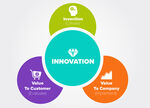13.02.2014
The Innovation Triangle – Defining a Culture of Success (Adam Rasheed, General Electric)
Have you ever googled the word „innovation?“ You get millions of results in no time. And that shows me just how overused the term innovation is today. And the same goes for the engineering sector, if the articles and advertisements in trade publications are any indication – and I’m not saying Haas Schleifmaschinen isn’t guilty of this as well. So in light of this flood of innovation, I am extremely excited about the guest post today on the subject of innovation. Adam Rasheed, Senior Research Engineer at GE General Electric Global Research, has written an excellent (!) essay that was first published on Ideas Lab.

[Translate to English:]
GE: Adam Rasheed.
The Innovation Triangle – Defining a Culture of Success
By Adam Rasheed
For decades companies have looked to innovation to differentiate themselves amidst intense global competition. Innovation workouts, initiatives, processes and a host of innovation-related “buzzwords” cropped up as companies scrambled to compete. The irony here is that there is no consistent, agreed-upon definition of innovation. A quick search on the web reveals dozens of different definitions for “innovation”.
Many authors tied innovation to invention, or rather the process of coming up with new ideas, whereas other authors indicated that generating value for the company was a critical part of innovation. Others highlighted implementation or commercialization, and many definitions were focused on new products. With such varied definitions of innovation, it quickly becomes apparent that a robust, practical definition is needed.
Why is a definition important? A solid definition is the foundation of a common language and a language is often thought of as the foundation of a culture. An appropriate and practical definition of innovation in a company can be used to drive the culture and form the basis of how the company views the evolution of its products, services, and business models. Furthermore, it can help inform the skills and resources that are needed to be successful and when they should be applied; an agreed upon definition can be the basis to drive an innovation culture in a company.
Working Definition of ‘Innovation’
We developed a working definition of innovation that could be practically applied. The Innovation Triangle [seen below] highlights the three main elements. When viewed as a noun representing an object, an innovation consists of the invention (the new idea), the value for the customer (customer proposition), and the value for the company (business proposition). This definition lends itself to understanding innovation as process, where the corners of the triangle can be mapped to the actionable verbs of create, evaluate and implement.

GE | Ideas Lab: The Innovation Triangle.
In order to be successful, an innovation must address all three elements. Two out of three are insufficient. For example, coming up with a new idea that nobody cares about would qualify as an invention, but not an innovation. In fact, there is generally no shortage of great ideas. Similarly, developing something new that is valuable for the customer, but does not generate value for the company is unsustainable. The real challenge lies in identifying those few new ideas that will be valuable to the customer and generate value for the company.
The Importance of Three
It is interesting to see that many innovations have had each of the three corners developed by different companies. Innovations are agnostic to corporate lines and this fact should strike fear into corporate leadership.
There are many famous examples of technology developed by one company, but abandoned since leadership did not recognize value to the customer or how to generate value for the company. Of course, hindsight is always perfect. Kodak’s invention of the digital camera and Xerox PARC’s inventions of virtually every aspect of personal computing (mouse, GUI, Ethernet) are routinely cited as examples of companies allowing others to capitalize on their inventions. In these situations, the R&D invested to develop the invention was essentially wasted, or worse, picked up by another company which brought it into the market place. The technology represented a successful innovation, however, the company which invested in the original research did not benefit from the resulting revenues. This type of example is the reason why a company needs to consider all three corners when developing something new. If your company doesn’t find a way to satisfy all three corners, someone else will be successful using your invention!
It is important to recognize the balance represented by the innovation triangle. Many companies invest heavily in research and development; however, having the best invention doesn’t necessarily mean it will be the best innovation. Once again, there are many famous examples of a technically inferior product thriving in the marketplace. The reason? The inferior product had the best combination of all three corners of the triangle. Investing in a new innovation means more than simply investing in R&D, but also investing in developing new business models to generate company and customer value. Leadership’s responsibility is to see the big-picture and appropriately invest in all the areas required to bring a successful innovation to market. This is where a definition of innovation becomes critical as it provides a framework for the discussions.
Obviously, just having a definition of innovation is not going to guarantee a company’s success. What it does do, however, is provide the basis of a much needed conversation. The definition proposed in this article might not be for everyone. In fact, every company needs to develop its own personalized definition of innovation that is actionable and can be tied directly to corporate processes. In addition to providing a common language, the implications are far-reaching beyond just research & development activities in defining the innovation culture.
Does your company have a commonly agreed-upon definition of innovation? How does that definition impact the vision for new products and services, the role of each department in contributing to the innovation culture, human resources, compensation and incentives, team formations, new business models and the ability to test them prior to market introduction? All of these are tough questions that start with a good definition.
Adam Rasheed is a Senior Research Engineer at GE Global Research.

Haas Schleifmaschinen: Deep in the matter.
Here in our blog we recently had the idea to develop a grinding machine on wheels. Whether or not we’re going to make it happen this year remains to be seen. But what we are going to present at the GrindTec 2014 are several new developments in grinding technology and grinding software that will primarily benefit manufacturers of precision tools.
What do you think an innovative grinding machine sould look like? Discuss it here on our blog with us or come to the GrindTec 2014 in Augsburg. You’ll find us in Hall 7 at Booth 7001.
See you soon – and Keep grinding with attitude!
Thomas Bader and Dirk Wember




Comments (0)
Write a comment